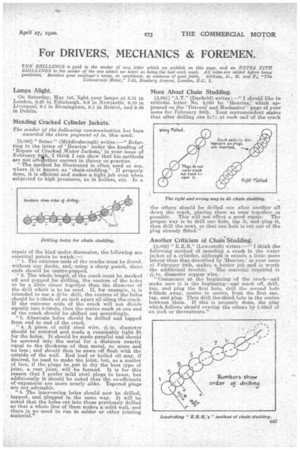For DRIVERS, MECHANICS & FOREMEN.
Page 27

If you've noticed an error in this article please click here to report it so we can fix it.
TEN SHILLINGS is paid to the sender of any letter which we publish on this page, and an EXTRA FIVE SHILLINGS to the sender of the one which we select as being the best each week, All notes are edited before being published. Mention your employer's name, in confidence, as evidence of good faith. Address, A, 111. and F., "The • Commercial Motor," 7-15, Rosebery Avenue, London, EX. .1.
Lamps Alight.
On Saturday, May lst, light your lamps at 8.51 in London, 9.20 in Edinburgh, 9.9 in Newcastle, 9.10 in Liverpool, 9.1 in Birmingham, 9.1 in Bristol, and 9.46 in Dublin.
Mending Cracked Cylinder Jackets.
The sender of the following communication has been awarded the extra payment of 58. this week.
[2,080] " Setao " (Middlesbrough) writes :—" Refer_ ring to the letter of ' Heavies' under the heading of
Repair of Cracked Water Jackets,' in your.issue of February 24111, I think I can show that his enethods are not altolether correct in theory or practice. "The method he illustrated is often used at sea, where it is known as chain-studding.' If properly done, it is efficient and makes a tight job even when subjected to high presSures, as in boilers, etc. In a repair of the kind under discussion, the following are essential points to watch:— "1. The extreme ends of the cracks must be found, without any doubt, and, using a sharp punch, these' ends should be centre-popped. "2. The whole length of the crack must be marked off and popped for drilling, the centres of the holes to he a little closer together than the diameter of the drill which is to be used. If, for example, it is intended to use a Alin. drill, the centres of the holes should be 5-32nds of an inch apart all along the crack. If the extreme ends of the crack will not divide equally into 5-32nds then the centre mark at one end of the crack should be shifted out accordingly. "3. Alternate holes should be drilled and. tapped from end to end of the crack.
" 4. A piece of mild steel wire, diameter should be screwed and made a reasonably tight fit for the holes. It should be made parallel and should be screwed into the metal for a distance exactly equal to the thickness of that metal, nc more and no less; and should then be sawn off flush with the outside of the wall. Red lead or boiled oil -may, if desired, be used to make the joint, hut, as a matter of fact, if the plugs be.put in dry the best type of joint, a rust joint, will be formed. It is for this reason that I prefer mild steel plugs to brass, but additionally it should be noted that the co-efficients ol expansion are more nearly alike. Tapered plugs are not advisable.
"5. The intervening holes should now be drilled, tapped, and plugged in the same way. It will be noted that the holes cut into those previously drilled so that a whole line of them makes a-solid wall, and there is no need to run in solder or other jointing material."
More About Chain Studding.
[2,081] "AT." (Darfield) writes :—" I should like to criticise letter No. 2,058 by 'Heavies,' which appeared on the 'Drivers' and Mechanics' page of your issue for 'February 24th. Your correspondent states that after drilling ene heie. at each es-d'of the crack the others should be 'drilled one after another all down the crack, placing them as near together. as possible. This will not effect a, good repair. The proper way is to drill one hole, tap it, and 'plug it, then drill the next, so that one. hole is cut out of the plug already fitted."
Another Criticism of Chain Studding.
[2,082] " E.R.R." (Lowestoft) writes : —" I think the following method of mending a crack in the water jacket of a cylinder, although it entails a little more labour than that described by `Heavies,' in your issue of February 24th, makes, a better job and is worth the additional trouble. The material requiled is diameter copper wire. "Commence at the beginning of the crack—and make sure it is the beginning—and mark off, drill, tap,. and plug the first hole, drat tho second hole 9-32nds away, centre to centre, from the first one, tap, and plug. Then drill thetthird.hole.in the centre' between them.. If this is properly done, the plug which, follows should overlap the others by 1-32nd of an inch or thereabouts."




























